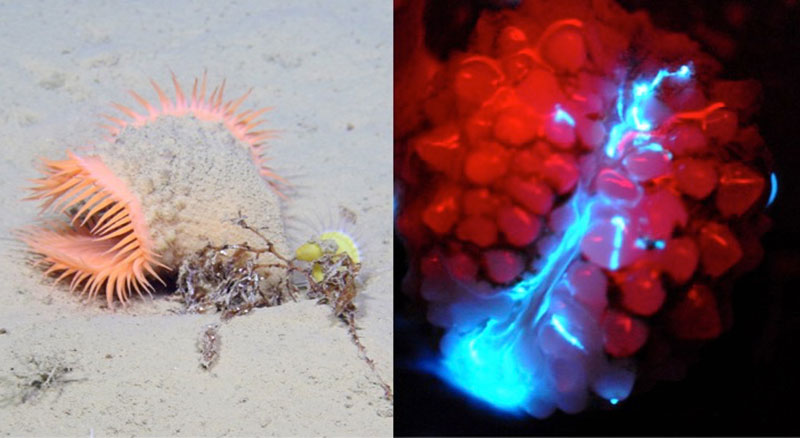How do living organisms produce light?
Living organisms may produce their own light via the processes of bioluminescence, fluorescence, or phosphorescence.

The image on the left is an in situ photograph of a hormathiid anemone; the image on the right shows the bioluminescent light emitted from the same animal. The emitted light is blue and comes from a mucous secretion. The animal is not actually red, but scientists briefly shined a red LED on it to show the light emission. Image courtesy of Sönke Johnsen and Katie Thomas. Download image (jpg, 24 KB).
While deep areas of the ocean are almost completely dark, light still plays an important role in these environments. The ability of an organism to create its own light could put it at a competitive advantage in situations such as during the hunt for food, evading predators, or finding mates.
Marine animals produce their own primarily by three different processes:
- Bioluminescence is a form of chemiluminescence, which is the production of visible light by a chemical reaction. When this kind of reaction occurs in living organisms, the process is called bioluminescence. It is familiar to most of us as the process that causes fireflies to glow. While rare in terrestrial ecosystems, bioluminescence is more common in the marine environment. Chemiluminescent reactions produce light without any prior absorption of radiant energy. While usually blue in color, because this is the light that travels best through the water, bioluminescence can range from nearly violet to green-yellow (and very occasionally red).
- Fluorescence happens when a fraction of the light illuminating an object is absorbed and then re-emitted as a different color. When you shine an ultraviolet light on a blacklight poster and it glows, that is fluorescence. Fluorescence in marine animals living in the upper to middle part of the water column is usually bright and concentrated in certain body parts. Scientists think that fluorescence in these animals may play a specific function, such as attracting prey or providing visual recognition. In contrast, fluorescence in organisms living on the deep-sea bottom seems to be more of a byproduct of particular tissue biochemistry and less likely to play any particular adaptive role.
- Phosphorescence is similar to fluorescence in its chemistry; however, unlike fluorescence, phosphorescent materials continue to emit light for a much longer time after the external light that triggered the radiation is removed. The glowing hands on watches and clocks are familiar examples.